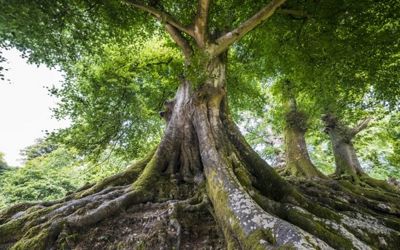Trees are by far the largest species on Earth. Height development is made possible by a sophisticated vascular system that conducts water from the roots to the leaves with high quality, while at the same time ensuring stability. The so-called xylem, also known as wood, is a network of hollow cells with extremely strong cell walls that reinforce cells against mechanical conflicts resulting from high growth. These walls coil around the cells in a filigree band and spiral pattern. So far, it is only partially understood how these patterns are formed.
Scientists from the Max Planck Institute for Molecular Plant Physiology in Golm/Potsdam and from Wageningen University and their colleagues study the formation of such reinforced and patterned cell walls.
Plants, especially trees, are by far the tallest organisms on Earth. Height growth is made possible by a specialized vascular system. This system conducts water from the roots to the leaves with high efficiency, while simultaneously thanks to extremely strong cell walls -providing stability.
Through a mixture of experiments and computer simulations, researchers at Wageningen University & Science, in collaboration with colleagues in Germany and Australia, have been able to analyze the evolution of this device in more depth and imagine it in a spectacular way. Their reports have been published today in Nature Communications and may lead to, among other items, the adaptation of plants and crops to climate change in the future.

Plants and trees stabilize their water pipes to grow taller
Plants draw water from the soil from the roots and transport it through the vascular system, the so-called xylem, to the canopy. The xylem is a network of tubular cell wall containers created by living xylem cells during plant development. Before their death, the cells deliberately coordinate the deposition of an extraordinarily powerful wall—the so-called secondary wall—in-band and spiral patterns. After that, the cells dissolve and clear the inside, and lignify the walls to provide these systems with strength, durability, and waterproofness. Because of this, xylem cells have both an effective water transport mechanism and plant stability.
Cellulose is the main load-bearing portion of xylem walls. In order for cellulose to shape these visually spectacular band shapes, it requires the aid of different proteins. This includes the so-called microtubules—small, tubular protein structures that are part of the cytoskeleton—which provide molecular ‘tracks’ for cell-wall-producing machines. This unit travels around the microtubules like an asphalt paver and constantly deposits wall material on the outside of the cells. Microtubules then serve as an instruction manual for cell wall synthesis. Despite much research into the general formation of cell walls, it has not yet been clear how the microtubule cytoskeleton is reorganized into such filigree patterns during secondary wall formation.
Arabidopsis with xylem cells
“One problem in elucidating these mechanisms has been the deep-tissue localization of the xylem, being buried underneath many cell layers. Due to this, it cannot be observed directly. We are using a genetic engineering approach to make this process visible under the microscope,” states René Schneider of the Max Planck Institute for Molecular Plant Physiology. The researchers used Arabidopsis thaliana (thale cress), an inconspicuous weed and model plant for testing, and changed it in such a way that all its cells could be forced to form xylem and thus secondary cell walls.
“For this purpose, we have equipped our plants with a ‘gene switch’. This makes it possible to trigger the mechanism of xylem development from the outside in a targeted manner. By that, all cells in the plant are becoming xylem cells, particularly the ones at the surface which are easy to study with high-resolution microscopy,” Schneider explains. Through this process, xylem cells and their wall patterns can be studied for the first time as they grow.
Using this new instrument, researchers are explaining which processes are guiding the rearrangement of microtubules during xylene formation. They established an automated imaging system and found that the microtubules and spirals form concurrently over the entire cell surface and the resulting pattern is further modified before the ordered distribution of the bands is reached. During this process, the microtubules in the holes are constantly broken down while rising in the bands.
The re-arrangement of parallel, equally spaced bands takes about one to two hours and is retained for the remaining time. The whole process of transformation of a cell into a proper xylem cell takes a total of several days. With the aid of their observation of plants and the use of computer simulations, the team of scientists was also able to classify a protein complex, KATANIN, which turned out to be involved in the timely and orderly forming of secondary walls.
On the basis of these results, Dr. René Schneider will further pursue the study issue of precisely how secondary wall patterns are shaped in plants. It is also funded by the German Research Foundation (DFG) under the Emmy-Noether-Program to set up a research group at the University of Potsdam. The study group is funded with EUR 1.3 million and will use in-vivo (in live plants), in-vitro (in the laboratory, beyond the plant) and computer-based approaches to further investigate the genetics and biophysics of cell wall pattern forming.
The work of the group is not only of importance to plant science but may also lead to the adaptation of plants to the future environment, as the survival of trees in a changing climate depends primarily on the adaptability of xylem vessels. Identifying proteins and associated genes that adapt the vascular system to environmental factors may help to classify or even genetically engineer more climate-resistant plant organisms.














